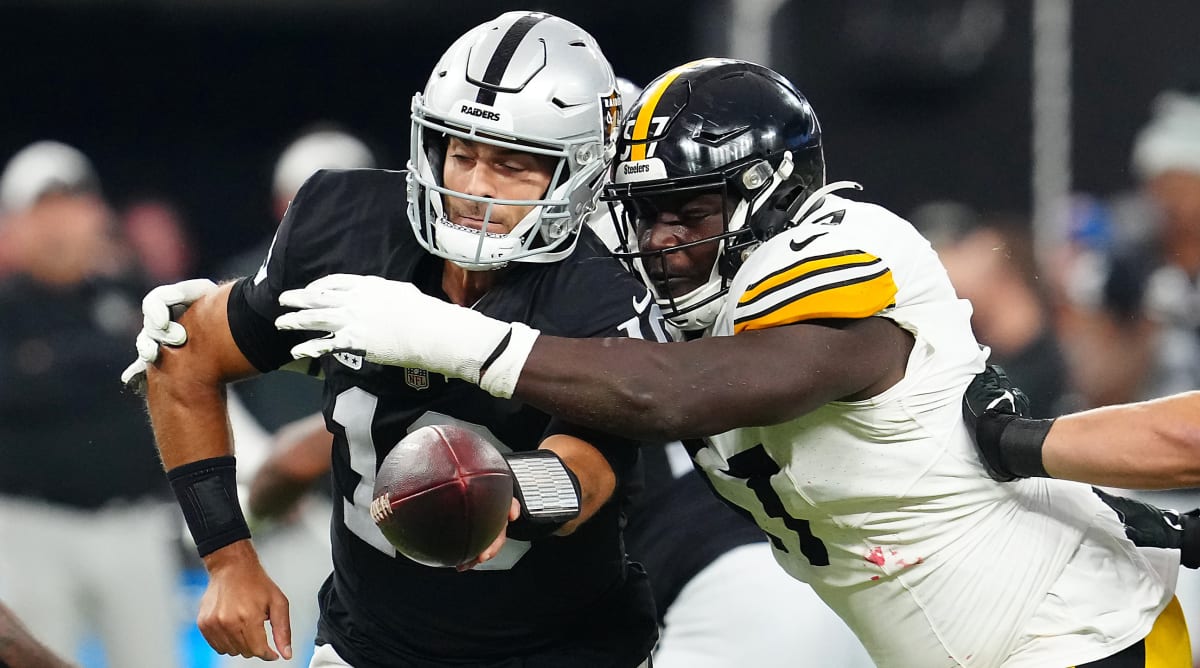The Sunday Night Football broadcast crew repeatedly compared the matchup between the Raiders and Steelers to the throwback style of smash-mouth 1970s football in an attempt to draw enthusiasm for the slow football that took place. In reality, outside of watching two of the best pass rushers in the league, T.J. Watt and Maxx Crosby, make life difficult for the opposing quarterback, there wasn’t much excitement in Las Vegas—especially not on a Sunday that saw the Dolphins light up the scoreboard for 70 points against the Broncos.
Not even the Raiders’ comeback attempt midway through the final quarter could turn this Week 3 matchup from a slogfest to a slugfest. There’s nothing wrong with appreciating football from the ’70s, but if you want real physicality, wait until the 49ers play the Cowboys in two weeks or the Eagles in December.
And, yes, the Cowboys surprisingly fell to the Cardinals earlier Sunday, but they’ll likely be in the mix as contenders because they have a well-balanced team with all three phases in mind. More importantly, they know how to score in a hurry on most Sundays.
The Raiders and Steelers limit themselves by striving to be balanced offenses with a conservative approach that resembles football from the past. They’re far from being a complete team for today’s standards because they lack firepower offensively—and maybe the right quarterback—to consistently make plays downfield. The Steelers have fewer problems because they won another clunky game after defeating the Raiders, 23–18. Pittsburgh is also much further along defensively when compared to the Raiders and most teams in the NFL.

Stephen R. Sylvanie/USA TODAY Sports
Second-year quarterback Kenny Pickett showed improvements in Week 3, which allowed the Steelers to marry the pass with the running game. It worked against the Raiders, and this ball-control offense might be enough to give the Steelers a wild-card playoff spot. But Pickett is going to have to generate more explosive plays the same way he did in the preseason to turn the Steelers (2–1) into legitimate threats in the AFC. The Steelers didn’t score during the final 18 minutes of regulation.
As for the struggling Raiders (1–2), they can at least say they have a Pro Bowl running back (Josh Jacobs), wide receiver (Davante Adams) and edge rusher (Crosby). Besides being top-heavy, they remain a work in progress during Year 2 with coach Josh McDaniels, who made a questionable decision to kick a field goal instead of go for a potential game-tying touchdown with an eight-point deficit with just over two minutes left in regulation. Perhaps he would have gone for it had he had Tua Tagovailoa as his quarterback.
No one expected Jimmy Garoppolo to turn the Raiders into the 49ers’ offense, but McDaniels likely wanted him to run an efficient attack that would allow his playmakers to pad their stats while controlling the time of possession. The problem with that approach, however, is plenty needs to go right early in games, such as jumping out to leads and establishing a ground game. The latter hasn’t occurred through Week 3 despite the Raiders getting two touchdown receptions from Adams early in their past two games, including in the first quarter on Sunday.
But explosive downfield plays have developed at a snail’s pace for the Garoppolo-led Raiders. The Raiders weren’t down by 50 like the Broncos, but they had a daunting challenge with a 16-point deficit in the fourth quarter along with poor protection for Garoppolo, who was pressured often and took a vicious hit from Watt near the end of the first half. The Raiders made it interesting with Garoppolo force-feeding Adams, whose one-yard touchdown trimmed the deficit to eight points after the Raiders also converted on a two-point conversion with 5:41 left in regulation.
Garoppolo finished 28-of-44 for 324 yards, two touchdowns and three interceptions. Pickett completed 16-of-28 passes for 235 yards, two touchdowns and no interceptions.
Las Vegas and Pittsburgh aren’t historically known as high-scoring franchises, but they each had one touchdown that went 30-plus yards in the opening quarter. First, Garoppolo connected with Adams for a 32-yard touchdown on a fourth-and-1 play that gave the Raiders the early 7–0 advantage. A few plays later, Pickett found Calvin Austin III in the middle of the field for a 72-yard touchdown to tie the game with 6:12 left in the first quarter.
After the mini scoring outburst, the two offenses returned to their sluggish ways for the remainder of the opening half. Each had trouble against the opposing teams’ star edge rusher—Watt had two sacks and Crosby had one by halftime. The Steelers started the second half with a 13–7 advantage thanks to two field goals from Chris Boswell. They also owed a debt to Raiders cornerback Marcus Peters, who dropped an interception with open space to the end zone to let Pickett narrowly avoid throwing a pick-six.

Stephen R. Sylvanie/USA TODAY Sports
The Raiders don’t have the personnel to consistently push the ball downfield, but they do have the weapons for a ball-control offense with Adams and Jacobs, the reigning rushing champion. But Jacobs, who missed all of training camp because of a contract dispute, has struggled to find a rhythm this season.
Jacobs had nowhere to go but up after being held to negative-two rushing yards against the Bills in Week 2. Jacobs mustered just 62 yards on 17 carries against the Steelers.
Pittsburgh had a bit more success on the ground, something that has been an issue dating back to last season. But the Steelers’ physical defense paired with enough offense from Pickett got the job done in Las Vegas.
As coach Mike Tomlin said last week, the Steelers won’t apologize for winning in an ugly fashion.
Sometimes ’70s football wins games. But scoring 70 points—or even half of that—is a much more viable path to winning in today’s football.







